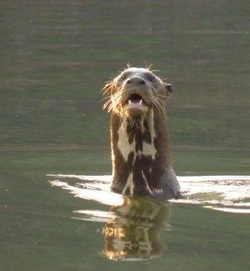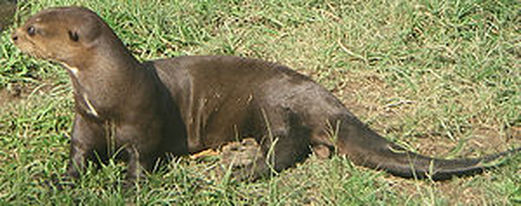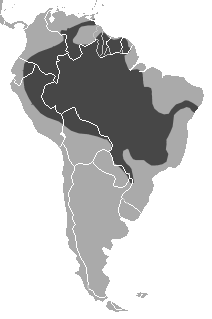Giant OtterPteronura brasiliensis |

Custom Search
|
|
The giant otter (Pteronura brasiliensis) is the largest representative of the family Mustelidae, measures up to 180 cm long and weighs up to 34 kg. Spends most of his life in wet environments like swamps, banks of rivers and freshwater lakes.
It is an animal native to South America, in Brazil is mainly found in the Amazon basin and the Paraná Basin. Besides Brazil it can be found in Bolivia, Colombia, Ecuador, French Guiana, Guyana, Paraguay, Peru, Suriname and Venezuela. From the chin to the chest their coat is white, the rest of the body is brown, and the point of the snout is hairy. When they are wet their hair becomes even darker. His tail is muscular and flattened from the middle to the tip, being of great help for mobility in the water. Giant Otters live in family groups which include monogamous parents and the offspring of multiple breeding seasons. They generally live in groups of up 10 animals, but can form groups up to 20 individuals. A group of giant otters uses a 12 km2 wide area as its territory. Giant otters swim and dive very well, they often build burrows on the banks of rivers and lakes to provide shelter, which are also used to breed.
They have diurnal habits, and these are noisy and playful animals, they emit up to 9 distinct vocalizations to indicate alarm, reassurance aggressiveness, etc.
They have small and round ears and like their nostrils they can be closed when the giant otter dives underwater. Their feet are large and feature an inter-digital membrane. They possess large eyes and sensitive whiskers that they use to help them detect and catch prey. When young they fall prey to caimans, jaguars, pumas, but as an adult the giant otter has very few predators aside from humans. Their typical lifespan is about 12 to 14 years in the wild. Giant Otter - Diet The species consumes each day, about 10% of their body weight in food because of their high metabolic rate They feed on fish like the red belly piranha, small mammals, birds, invertebrates and reptiles like small caimans and anacondas. The prey is captured with the mouth and then maintained securely in their paws to be eaten, most often while the animal swims on his back. Giant Otter - Reproduction Breeding season occurs from January to March, the gestation lasts about 70 days and are born from 1 to 5 young, 2 on average. The young remain in the burrow until they are 3 months at the end of 3 months they come out and join the group, who will fiercely defend them from predators. With 1 year, they are already independent, and between 2 and 3 years, they reach sexual maturity. Giant Otter - Conservation status and major threats It is classified by the IUCN (International Union for Conservation of Nature) as an endangered species, but at least some protected populations are recovering. The giant otter is an endangered species, because it was hunted for many years because of their pelt, which is soft and silky. The other threats are habitat destruction and water pollution by pesticides, industrial wastes and mercury. Habitat loss significantly influences their likelihood of survival and it is estimated that the loss of habitat will cause population decline by 50% in 20 years.
|
Scientific classification
Kingdom: Animalia Phylum: Chordata Class: Mammalia Order: Carnivora Family: Mustelidae Subfamily: Lutrinae Genus: Pteronura Species: P. brasiliensis |



